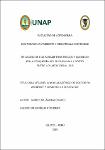Relación de los parámetros físicos y químicos en la pesquería del río Ucayali, Loreto entre los años 2005 al 2015
Abstract
El presente estudio tuvo por objetivo conocer la relación de los parámetros físicos y químicos en la pesquería del río Ucayali (Perú) entre los años 2005 al 2015. A partir de una base de datos generada con los registros de parámetros fisicoquímicos del agua y volúmenes de desembarque del alto, medio y bajo Ucayali, información proporcionada por la Direcciones Regional de Salud y de la Producción de Loreto y Ucayali. Luego, se hizo el análisis descriptivo, inferencial y relación (correlación y análisis de componentes principales – ACP). Los resultados muestran que los desembarques estuvieron compuestos por 64 especies, del cual, el 76.56% fueron especies pequeñas. Asimismo, el desembarque anual fue de 8 019.87 t, con registros diferentes en cada tramo (P<0.05), siendo Prochilodus nigricans (24.94%), Potamorhina altamazonica (8.19%) y Pseudoplatystoma punctifer (6.71%) las más importantes desembarcadas. Por otro lado, los parámetros físico-químicos del agua en cada tramo del río fueron diferentes (P < 0.05), y solo la temperatura estuvo asociado con la disminución de los desembarques en el tramo alto del río Ucayali, por cuanto, es necesario el desarrollo de lineamientos para la generación de información y la gestión desde un enfoque más integral y de co-gobernanza en tiempo y espacio específicos. Se concluye que el río Ucayali se caracteriza por la ausencia de relación entre sus parámetros fisicoquímicos y los desembarques pesqueros que fueron diferentes en los tres tramos del río, a excepción de la temperatura, siendo oportuno la implementación de lineamientos para la generación de información y la gestión de las pesquerías. The objective of this study was to know the relationship between physical and chemical parameters in the Ucayali river fishery (Peru) between 2005 and 2015. Using descriptive techniques and relationship analysis: correlation, Principal Component (ACP) and regression. The results show that the landings were composed of 64 small species, of which, 76.56% were small. Likewise, the annual landing was 8019.87 t, with different records in each section (P <0.05), being Prochilodus nigricans (24.94%), Potamorhina altamazonica (8.19%) and Pseudoplatystoma punctifer (6.71%) the most important landed. On the other hand, the parameters in each section of the river were different (P <0.05), and only the temperature was associated with the decrease of the landings in the upper part, while the development of guidelines for the generation of information and the management from a more integral approach and co-governance in specific time and space. In conclusion, the Ucayali river is characterized by the absence of a relationship between the parameters and the fishing landings that are different in the three stretches of the river, an exception of the temperature, being the implementation of guidelines for the generation of information and the management of fisheries with a more integral and participatory approach.
Collections
- Tesis [57]
The following license files are associated with this item:


